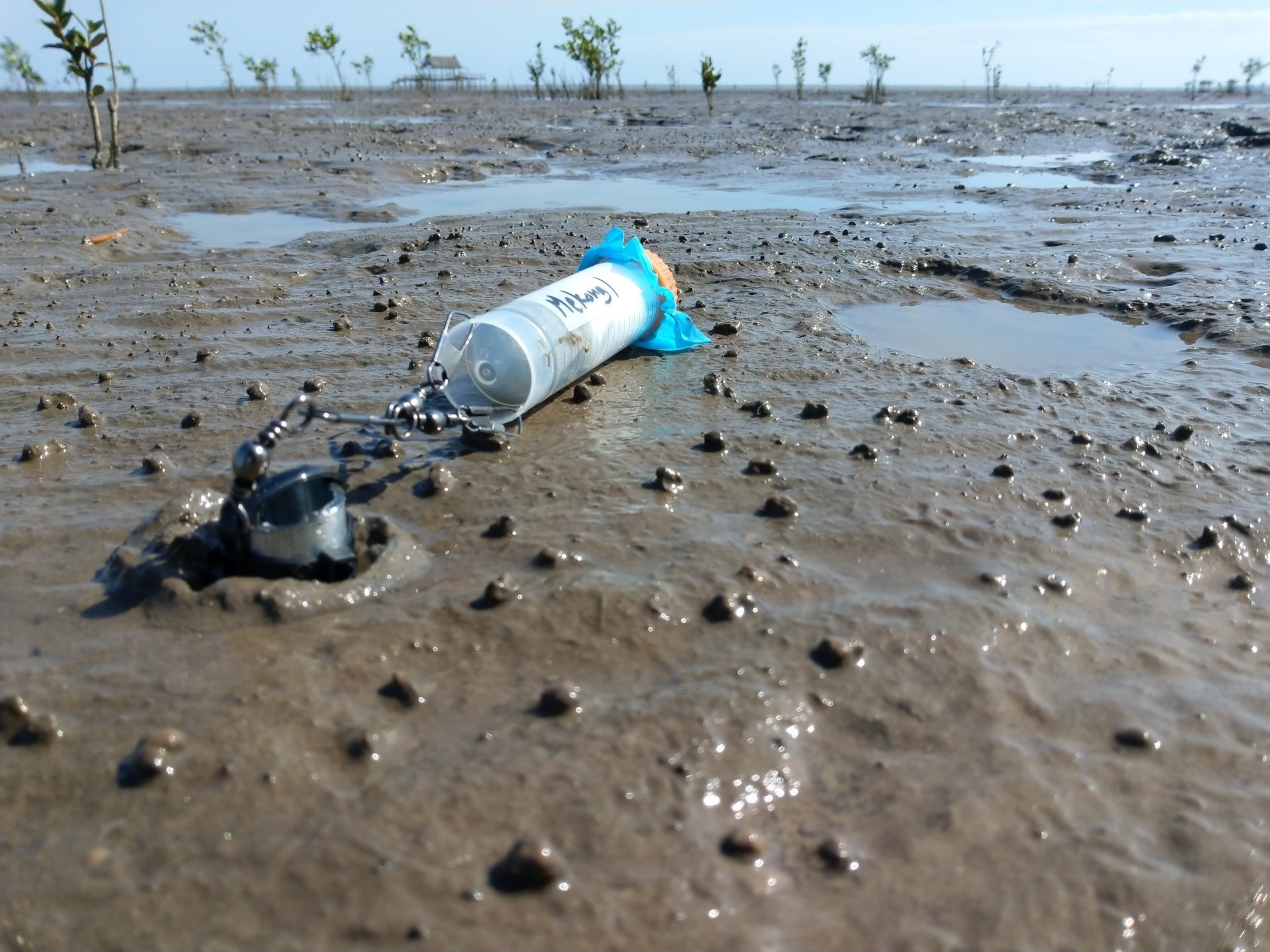Inexpensive & open-source sensors could dramatically improve the success of mangrove plantation schemes.
Author: Cai Ladd, Glasgow University
Mini-buoy
During our scoping visit along the Bangladesh coast in 1 B.C. (Before Covid), we came across a mangrove plantation in Kakrabunia village, Dacope upazila. This was the first time I’d encountered a mangrove forest. Before then, I’d only ever seen them in David Attenborough’s documentaries, or imagined them from reading academic papers. The moment was bittersweet. This little mangrove plantation represented that which had been lost, and an aspiration to reverse the damage done.
I learned that the mangrove plantation had a surprising and inspiring story . As a boy, Diponkor Mondol watched helplessly as the Shibsha river ate away at its banks, eroding his precious land. As a man, Diponkor had a plan to protect his village against the erosion by planting mangrove trees. Mangroves bind soils together and slow the flow of water , reducing erosion rates and capturing new sediment to rebuild the riverbank. With the support of the Adventist Development and Relief Agency (ADRA), Diponkor and his community planted mangrove saplings along a one-acre stretch of the riverbank. For all their hard work, the saplings died a year later. Diponkor would be heartbroken, but he didn’t give up. With his wife, Nobonika, they collected mangrove seeds washed in from the Sundarbans. The pair nurtured the saplings at home and replanted them when they matured.
The prelude of this story is, sadly, all too common. A huge number of projects fail simply because the wrong mangrove trees are being planted in the wrong locations. Incredibly, long-term survival rates of mangroves are as low as 10%. There is an urgent need to improve the success rate of mangrove restoration schemes. Since the 1980s, mangrove forests around the world have declined by 20%. Mangrove deforestation not only affects local coastal communities who rely on the forests for timber, fishing, and flood protection, but impacts on everyone since deforestation releases CO2 stored in mangrove trees and soil contributing to climate change. Restoring mangrove forests is now high on the agenda of many governments and NGOs. For their efforts, mangrove forests have increased in many countries across south-east Asia. The story in Vietnam is particularly encouraging. The country successfully reversed its decline of mangrove forest in 2001. To replicate the successes of mangrove restoration around the world, managers need good information on where to plant mangroves.
Where to Restore?
Deciding where on the coast to plant mangrove saplings is like Goldilocks choosing porridge. Exposure to waves, currents, and flood duration need to be just right for the trees to thrive. Conditions at the coast change throughout the seasons, so to get a good idea of a site’s suitability for mangrove planting requires several months’ worth of monitoring. This is especially important for capturing the infrequent extreme events, like storms and floods, which can dislodge saplings. However, monitoring hydrological conditions at the coast is tricky. Conventional hydrological equipment is expensive, requires specialist knowledge to use, and risks being washed away or stolen. It’s no surprise that practitioners often base their decisions on whether or not a site is suitable for mangrove planting on very little or no monitoring at all. Without a better way to survey the coast, planting in the wrong places is likely to continue.
Alongside colleagues in the U.K., U.S., Canada, and Indonesia collaborating the Newton Fund project MOMENTS, we’ve recently submitted an article describing the design, calibration, and application of an inexpensive and open-source sensor for monitoring hydrodynamics at the coast. We call our sensor the ‘Mini Buoy’. The Mini Buoy is a battery-powered accelerometer and data logger contained in a standard centrifuge tube. The Mini Buoy is anchored to the ground by a fishing line, and bobs about in the water when inundated. Motion along the axis of the accelerometer is used to measure inundation, currents, and waves. The Mini Buoy costs less than $400 to assemble, and the materials to build one can be purchased around the globe. Given their low cost, several Mini Buoys can be deployed across a site for up to 6 months, gathering detailed information on where best to plant mangrove trees. We even have a handy App, so anyone can upload data and find out if a site is suitable for restoration.
My co-authors trialled the Mini Buoys along a series of abandoned shrimp ponds in North Sumatra. Mangrove trees once flourished here before being mostly felled in 2002. The Mini Buoys showed us that the first pond was too wet for restoration (a sluice gate kept the water in during high tide). The second pond was just right for the pioneer mangrove Avicennia spp. The third pond was just right for a different mangrove species, Rhizophora apiculata, which had already been planted in May 2019. The Mini Buoy has helped us conclude which sites are suitable for restoration, and which are not. We’ve in the process of improving how well the Mini Buoy can detect waves, then we’ll have a three-in-one sensor for taking long-term hydrodynamic measurements for coastlines around the tropics.
Abandoned Pond 1
Abandoned Pond 2
Pond Restoration
Maybe the jury’s still out on whether or not Diponkor’s mangrove plantation will survive in the long-term. If we’re to restore the world’s mangrove forests, we need to dramatically increase the success rates of plantation schemes. Mini Buoys offer a practical way to achieve this.





